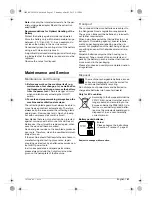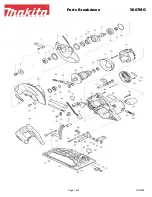
English |
39
1 619 P12 706 • 5.3.15
Mounting the Saw Blade (see figure A)
For changing the cutting tool, it is best to place the
machine on the face side of the motor housing.
– Clean the saw blade
23
and all clamping parts to
be assembled.
– Tilt back the retracting blade guard
21
and hold
firmly.
– Place the saw blade
23
onto the mounting flange
22
. The cutting direction of the teeth (direction of
arrow on the saw blade) and the direction-of-ro-
tation arrow on the retracting blade guard
21
must correspond.
– Mount the clamping flange
24
and screw in the
clamping bolt
25
turning in rotation direction
.
Observe correct mounting position of mounting
flange
22
and clamping flange
24
.
– Press the spindle lock button
6
and keep it
pressed.
– With the Hex key
5
, tighten the clamping bolt
25
turning in rotation direction
. The tightening
torque is between 6–9 Nm, which corresponds
to hand tight plus ¼ turn.
Dust/Chip Extraction
Before any work on the power tool, remove the
battery.
Dusts from materials such as lead-containing
coatings, some wood types, minerals and metal
can be harmful to one’s health. Touching or
breathing-in the dusts can cause allergic reac-
tions and/or lead to respiratory infections of the
user or bystanders.
Certain dusts, such as oak or beech dust, are
considered as carcinogenic, especially in con-
nection with wood-treatment additives (chro-
mate, wood preservative). Materials containing
asbestos may only be worked by specialists.
– To achieve a high level of dust extraction, use
a suitable dust extractor together with this
power tool.
– Provide for good ventilation of the working
place.
– It is recommended to wear a P2 filter-class res-
pirator.
Observe the relevant regulations in your country
for the materials to be worked.
Mounting the Extraction Adapter (see figure B)
Fasten the extraction adapter
29
to the base plate
7
with the fastening screw
28
.
A vacuum hose with a diameter of 19 mm can be
connected to the extraction adapter
29
.
The extraction adapter may not be mounted
when no external dust extraction is connect-
ed.
Otherwise the extraction channel can be-
come clogged.
Do not connect a dust bag to the extraction
adapter.
Otherwise the extraction system can
become clogged.
To ensure optimum extraction, the extraction
adapter
29
must be cleaned regularly.
External Dust Extraction
Connect vacuum hose
30
via adapter
29
(accesso-
ry) to the vacuum hose of a vacuum cleaner (acces-
sory).
The vacuum cleaner must be suitable for the mate-
rial being worked.
When vacuuming dry dust that is especially detri-
mental to health or carcinogenic, use a special vac-
uum cleaner.
Operation
Operating Modes
Before any work on the power tool, remove the
battery.
Adjusting the Cutting Depth (see figure C)
Adjust the cutting depth to the thickness of
the workpiece.
Less than a full tooth of the
blade teeth should be visible below the work-
piece.
Loosen wing bolt
17
. For a smaller cutting depth,
pull the machine from the base plate
7
; for a larger
cutting depth, push the machine toward the base
plate
7
. Adjust the desired cutting depth at the cut-
ting-depth scale
18
. Tighten wing bolt
17
again.
When setting the cutting depth, use the reference
mark
31
to the side of the cutting-depth scale
18
.
Adjusting the Cutting Angle
It is best to place the machine on the face side of
the blade guard
13
.
Loosen wing bolt
10
. Tilt the saw sidewards. Adjust
the desired setting at the scale
9
. Tighten wing bolt
10
again.
When setting the mitre angle, use the reference
mark
27
(upper edge of the holder).
Note:
For bevel cuts, the cutting depth is smaller
than the setting indicated on the cutting-depth
scale
18
.
Cutting Marks
The 0 ° cutting mark
12
indicates the position of the
saw blade for right-angled cuts. The 45 ° cutting
mark
11
indicates the position of the saw blade for
45 ° cuts.
OBJ_BUCH-2434-001.book Page 39 Thursday, March 5, 2015 2:19 PM



































